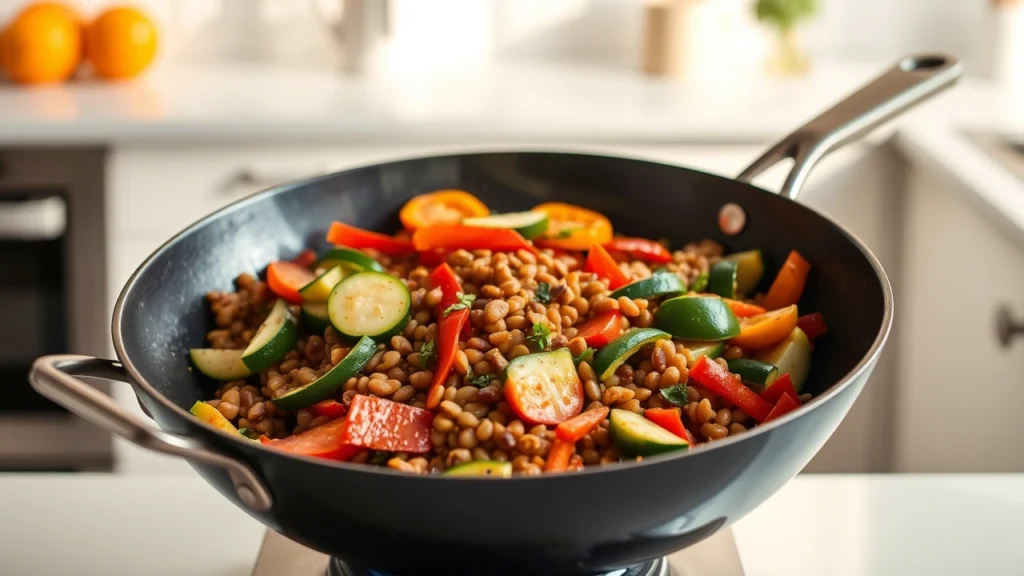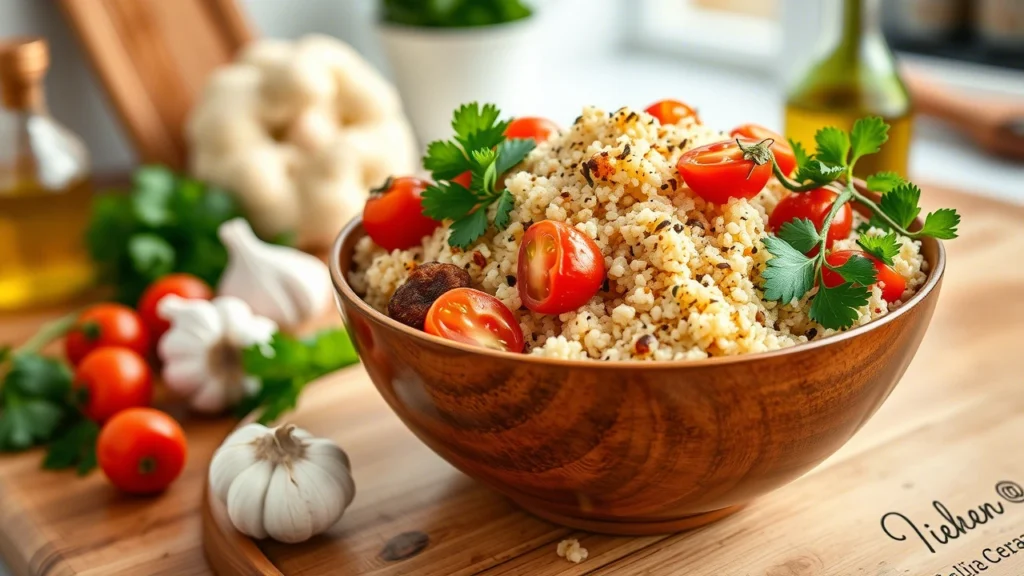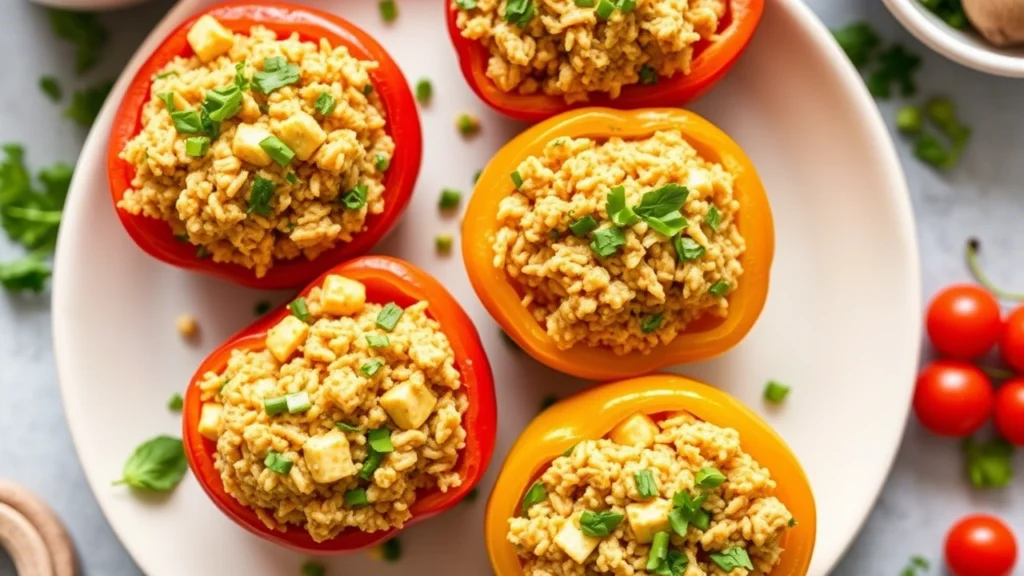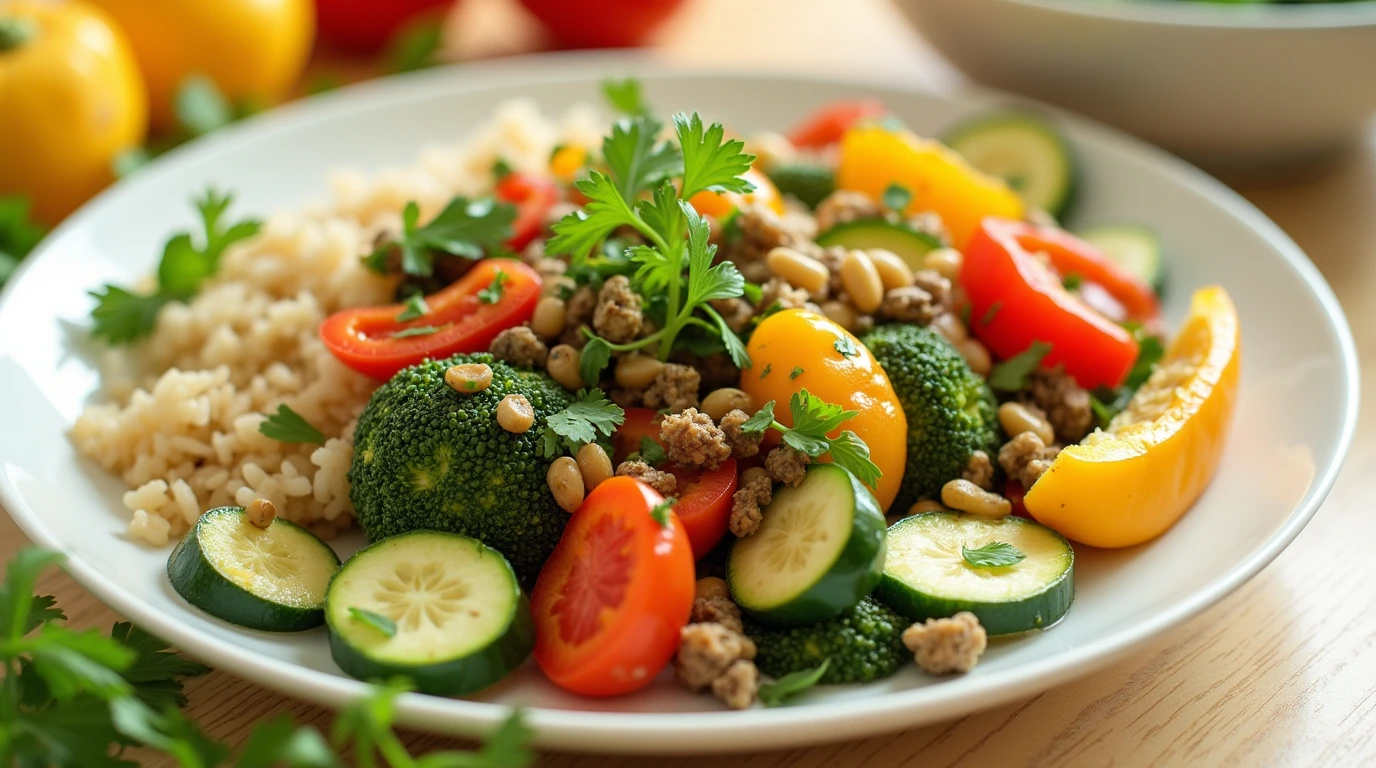Eating a healthy, balanced diet is essential for managing chronic kidney disease (CKD), and choosing the right vegetarian meals can make a big difference. If you’re looking for kidney-friendly vegetarian dinner ideas that are both nutritious and delicious, you’re in the right place!
A CKD-friendly diet focuses on controlling sodium, potassium, and phosphorus while ensuring you get enough protein without overloading your kidneys. In this post, we’ll explore easy and healthy vegetarian dinner recipes that support kidney health—without sacrificing flavor. Whether you’re newly diagnosed or looking for fresh meal ideas, these recipes will help you enjoy tasty and nourishing meals while taking care of your kidneys.
Table of Contents
Key Nutritional Considerations for CKD-Friendly Vegetarian Meals
Low-Sodium Choices: Use Herbs, Lemon Juice, and Salt-Free Seasonings Instead of Salt
When following a kidney-friendly diet, one of the most important things to watch is your sodium intake. Too much salt can lead to high blood pressure and extra strain on the kidneys, making it essential to find flavorful alternatives. The good news? You don’t need salt to make your meals delicious!
Why Reduce Sodium?
For people with chronic kidney disease (CKD), the kidneys struggle to remove excess sodium from the body. This can lead to fluid retention, swelling, and an increased risk of heart problems. By cutting down on salt, you help protect your kidneys and keep your blood pressure in check.
Flavorful Salt Alternatives
Instead of reaching for the salt shaker, try these tasty and kidney-friendly seasoning options:
- Fresh and Dried Herbs – Basil, oregano, thyme, rosemary, and cilantro add depth and aroma to dishes.
- Lemon Juice and Vinegar – A splash of citrus or vinegar brightens up meals and enhances flavors without needing salt.
- Garlic and Onion Powder – These add a rich, savory taste to soups, stews, and roasted vegetables. (Avoid garlic salt or onion salt.)
- Salt-Free Seasoning Blends – Look for pre-made mixes labeled “no salt added” or make your own using a mix of herbs and spices.
- Smoked Paprika and Cumin – These spices add warmth and a slightly smoky depth to your meals.
Simple Ways to Cut Back on Sodium
- Cook from scratch whenever possible to avoid hidden salt in processed foods.
- Rinse canned vegetables and beans to remove excess sodium.
- Use homemade broths or low-sodium vegetable stocks for soups and stews.
- Taste your food before adding any seasoning—you may not need extra salt at all!
Managing Potassium & Phosphorus: Limit High-Potassium Vegetables Like Potatoes and Use Substitutes Like Cauliflower or Zucchini
When you have chronic kidney disease (CKD), it’s important to monitor your potassium and phosphorus levels. While these minerals are essential for overall health, too much can put extra strain on your kidneys and lead to complications like muscle weakness, irregular heartbeat, and bone problems. Since the kidneys are responsible for filtering excess potassium and phosphorus, choosing the right vegetables can help keep your levels in check.
Why Limit Potassium and Phosphorus?
- High potassium levels (hyperkalemia) can affect heart function and lead to serious health risks.
- Too much phosphorus can pull calcium from your bones, weakening them over time.
- People with CKD need to be mindful of foods that contain excessive amounts of these minerals, especially when following a vegetarian diet.
High-Potassium Vegetables to Avoid or Limit
Some vegetables contain large amounts of potassium, which can quickly add up in your daily intake. While you don’t have to cut them out completely, it’s best to eat them in moderation or use preparation techniques (like leaching) to reduce potassium content. High-potassium vegetables include:
- Potatoes (white and sweet)
- Tomatoes and tomato-based sauces
- Spinach and Swiss chard
- Avocados
- Bananas (though not a vegetable, they are a common high-potassium food to watch out for!)
Kidney-Friendly Vegetable Substitutes
The good news is that there are plenty of tasty, low-potassium alternatives that can be used in your meals:
- Cauliflower – A great substitute for potatoes in mashed dishes, roasted sides, or even as a rice alternative.
- Zucchini – Mild in flavor and great for stir-fries, soups, or even spiralized as a pasta substitute.
- Cabbage – A versatile vegetable that works well in salads, slaws, and stir-fries.
- Bell Peppers – Naturally low in potassium and great for adding crunch and color to your meals.
- Radishes – A crisp, peppery vegetable that can be used in salads or roasted as a flavorful side.
Tips to Reduce Potassium in Vegetables
If you still want to enjoy some higher-potassium vegetables occasionally, try this method to lower their potassium content:
- Peel and chop the vegetables into small pieces.
- Soak them in warm water for at least two hours, changing the water a couple of times.
- Boil them in a large amount of water (avoid using the cooking water afterward, as potassium leaches out into it).
Protein Balance: Include Plant-Based Proteins Like Tofu, Chickpeas (in Moderation), and Lentils to Avoid Excess Protein Intake
Protein is an essential part of any diet, but for people with chronic kidney disease (CKD), getting the right amount of protein is crucial. Your kidneys help filter waste from protein metabolism, and eating too much protein can put extra strain on them. However, too little protein can lead to muscle loss and weakness. That’s why it’s important to find a balance—especially if you follow a vegetarian diet.
How Much Protein Do You Need?
The amount of protein needed depends on the stage of CKD:
- Early-stage CKD: Moderate protein intake is recommended to reduce kidney strain.
- Advanced CKD (before dialysis): A low-protein diet may be advised to slow kidney function decline.
- Dialysis patients: Higher protein intake is often necessary because dialysis removes protein waste from the body.
It’s always best to consult with a doctor or dietitian to determine the right amount of protein for your specific needs.
Best Plant-Based Protein Sources for CKD
If you’re on a vegetarian diet, you can still get enough protein without overloading your kidneys. Some of the best kidney-friendly plant-based protein options include:
- Tofu: A versatile, low-sodium, and kidney-friendly protein that works well in stir-fries, soups, and salads.
- Chickpeas (in moderation): While nutritious, chickpeas contain phosphorus and potassium, so portion control is important.
- Lentils (in moderation): A great source of plant protein but should be eaten in limited amounts to avoid excess potassium and phosphorus.
- Egg whites: If you’re open to animal-based proteins, egg whites are an excellent low-phosphorus protein option.
- Unsalted nuts (in small amounts): Almonds and walnuts provide protein but should be eaten sparingly due to phosphorus content.
Tips for Managing Protein Intake
- Spread your protein intake throughout the day to reduce kidney strain.
- Pair plant-based proteins with low-potassium vegetables for a balanced meal.
- Opt for fresh, unprocessed protein sources instead of packaged vegetarian meat substitutes, which may contain high sodium and phosphorus.
Easy & Healthy Kidney-Friendly Vegetarian Dinner Recipes
Recipe 1: Low-Sodium Lentil & Vegetable Stir-Fry
This low-sodium lentil and vegetable stir-fry is a simple, nutritious, and kidney-friendly meal that’s packed with plant-based protein, fiber, and essential nutrients—without the excess salt. It’s perfect for anyone managing chronic kidney disease (CKD) who wants a flavorful and satisfying dinner while keeping their sodium intake in check.

Why This Recipe is Kidney-Friendly
- Low in sodium: Uses herbs, spices, and natural flavors instead of salt.
- Moderate in potassium & phosphorus: Lentils are included in controlled portions to provide plant-based protein without overloading the kidneys.
- Rich in fiber: Helps with digestion and overall gut health.
- Packed with fresh vegetables: Uses low-potassium options for a balanced and nutritious meal.
Ingredients:
- ½ cup cooked lentils (rinsed and drained)
- 1 cup cauliflower florets (low-potassium alternative to potatoes)
- ½ cup sliced zucchini
- ½ cup bell peppers (any color)
- 1 small carrot, julienned
- 2 cloves garlic, minced
- 1 tablespoon fresh ginger, grated
- 2 tablespoons low-sodium vegetable broth or water
- 1 tablespoon olive oil
- 1 teaspoon lemon juice (for added flavor)
- ½ teaspoon turmeric (anti-inflammatory and flavorful)
- ½ teaspoon smoked paprika (adds a smoky taste without salt)
- ¼ teaspoon black pepper
- Fresh cilantro or parsley for garnish (optional)
- Sesame seeds for extra texture (optional)
Instructions:
- Cook the lentils: If not pre-cooked, rinse and cook the lentils in water (without salt) until tender. Drain and set aside.
- Sauté the aromatics: Heat olive oil in a large pan or wok over medium heat. Add the minced garlic and grated ginger, stirring for about 30 seconds until fragrant.
- Add the vegetables: Toss in the cauliflower, zucchini, bell peppers, and carrots. Stir-fry for 3–5 minutes until they start to soften.
- Season and enhance flavors: Pour in the low-sodium vegetable broth or water, then add turmeric, smoked paprika, and black pepper. Stir well to combine.
- Mix in the lentils: Add the cooked lentils to the pan and stir everything together. Let it cook for another 2–3 minutes, allowing the flavors to blend.
- Finish with freshness: Squeeze in the lemon juice and give it a final stir. Remove from heat and garnish with fresh cilantro or sesame seeds if desired.
- Serve and enjoy: This stir-fry pairs well with a small serving of cooked rice (white or brown, depending on dietary needs) or can be enjoyed on its own.
Tips for Customization:
- Swap out vegetables based on your kidney diet needs (e.g., use cabbage instead of carrots for a lower-potassium option).
- Adjust seasoning by adding more fresh herbs like basil or oregano for extra flavor.
- For extra protein, you can add small cubes of tofu or a few slices of avocado (if potassium intake allows).
Recipe 2: Quinoa & Roasted Cauliflower Bowl
This quinoa and roasted cauliflower bowl is a simple, nutritious, and kidney-friendly vegetarian meal that is packed with protein, fiber, and flavor—all while keeping potassium, phosphorus, and sodium in check. It’s perfect for a light yet satisfying dinner and can be customized to fit your dietary needs.

Why This Recipe is Kidney-Friendly?
- Low in sodium: No added salt, and all ingredients rely on natural flavors.
- Controlled potassium & phosphorus: Quinoa provides protein without overloading the kidneys, and cauliflower is a great low-potassium vegetable.
- High in fiber: Supports digestion and overall gut health, which is especially important for CKD patients.
- Plant-based protein: Quinoa is a complete protein, making this a well-balanced vegetarian meal.
Ingredients:
For the Roasted Cauliflower:
- 1 cup cauliflower florets
- 1 tablespoon olive oil
- ½ teaspoon smoked paprika (adds depth of flavor)
- ¼ teaspoon black pepper
- ¼ teaspoon turmeric (anti-inflammatory and flavorful)
- ½ teaspoon garlic powder
For the Quinoa Base:
- ½ cup cooked quinoa (rinsed before cooking to remove excess phosphorus)
- 1 tablespoon fresh lemon juice (brightens flavors naturally)
- 1 teaspoon olive oil
- ¼ teaspoon cumin (adds a warm, earthy taste)
Toppings (Optional & Customizable):
- ½ cup diced bell peppers (low in potassium and rich in vitamin C)
- ¼ cup shredded cabbage (adds crunch and fiber)
- 1 tablespoon fresh parsley or cilantro (for freshness and added flavor)
- 1 tablespoon toasted sesame seeds or pumpkin seeds (for texture, in small amounts)
Instructions:
Step 1: Roast the Cauliflower
- Preheat your oven to 400°F (200°C).
- In a bowl, toss cauliflower florets with olive oil, smoked paprika, black pepper, turmeric, and garlic powder.
- Spread the cauliflower evenly on a baking sheet and roast for 20–25 minutes, turning halfway through, until golden and tender.
Step 2: Prepare the Quinoa
- Cook the quinoa according to package instructions, using water or low-sodium vegetable broth instead of salt-heavy stock.
- Once cooked, fluff it with a fork and mix in lemon juice, olive oil, and cumin for added flavor.
Step 3: Assemble the Bowl
- In a bowl, add a base of cooked quinoa.
- Top with the roasted cauliflower.
- Add any additional toppings, such as diced bell peppers, shredded cabbage, fresh herbs, and a sprinkle of toasted sesame or pumpkin seeds for crunch.
Step 4: Serve & Enjoy
- Enjoy as a standalone meal or pair with a light kidney-friendly dressing, such as a simple mix of olive oil and lemon juice.
- You can also add a small portion of avocado or tofu for extra protein (if your potassium intake allows).
Tips for Customization:
- Want more protein? Add a few cubes of tofu or a spoonful of chickpeas (in moderation).
- Need a lower-carb option? Replace quinoa with more roasted cauliflower or a mix of cauliflower rice.
- Looking for extra flavor? Try adding fresh basil or a dash of apple cider vinegar for a tangy twist
Recipe 3: Stuffed Bell Peppers with Tofu & Brown Rice
These stuffed bell peppers with tofu and brown rice are a delicious, kidney-friendly vegetarian dinner option that is both satisfying and easy to make. Packed with plant-based protein, fiber, and essential nutrients, this dish offers a flavorful meal while keeping sodium, potassium, and phosphorus in check. Plus, bell peppers are naturally low in potassium and full of vitamin C, making them a great choice for people with chronic kidney disease (CKD).

Why This Recipe is Kidney-Friendly?
- Low in sodium: No added salt, using herbs and natural flavors instead.
- Moderate in protein: Tofu provides plant-based protein without overloading the kidneys.
- Balanced potassium & phosphorus: Brown rice is lower in phosphorus than many other whole grains, and bell peppers are a low-potassium vegetable.
- High in fiber: Helps support digestion and overall gut health, which is important for CKD patients.
Ingredients:
For the Stuffed Bell Peppers:
- 3 large bell peppers (any color – red, yellow, or green)
- ½ cup cooked brown rice (helps control phosphorus intake)
- ½ cup firm tofu, crumbled
- ½ cup diced zucchini (a great low-potassium vegetable)
- ¼ cup finely chopped carrots
- 2 tablespoons onion, finely diced
- 1 garlic clove, minced
- 1 teaspoon olive oil
- ½ teaspoon smoked paprika (for depth of flavor)
- ½ teaspoon dried oregano
- ¼ teaspoon black pepper
- ½ teaspoon lemon juice (to brighten the flavors)
- 1 tablespoon fresh parsley or cilantro for garnish
Instructions:
Step 1: Prepare the Bell Peppers
- Preheat your oven to 375°F (190°C).
- Cut the tops off the bell peppers and remove the seeds and membranes inside. Lightly brush the outside with a bit of olive oil and set them aside.
Step 2: Cook the Filling
- In a pan, heat 1 teaspoon of olive oil over medium heat.
- Add the diced onion and garlic, sautéing for 1–2 minutes until fragrant.
- Add the crumbled tofu, zucchini, and carrots. Cook for 3–4 minutes, stirring occasionally.
- Stir in the cooked brown rice, smoked paprika, oregano, black pepper, and lemon juice. Cook for another 2 minutes to blend the flavors.
- Remove from heat and let the mixture cool slightly.
Step 3: Stuff & Bake the Peppers
- Spoon the filling evenly into the hollowed-out bell peppers.
- Place the stuffed peppers in a baking dish with about ½ inch of water at the bottom (this helps steam them while baking).
- Cover with foil and bake for 25–30 minutes, until the peppers are tender but still holding their shape.
- Remove from the oven and let them rest for a few minutes before serving.
Step 4: Serve & Enjoy
- Garnish with fresh parsley or cilantro for extra flavor.
- Serve with a side salad or a small portion of steamed low-potassium vegetables for a complete meal.
Tips for Customization:
- Want extra flavor? Add a small amount of cumin or turmeric for a warm, earthy taste.
- Prefer a different grain? Swap brown rice for quinoa or cauliflower rice if you need a lower-phosphorus option.
- Looking for more protein? Add a sprinkle of unsalted sunflower seeds for texture and extra protein.
- Want a little kick? Add a pinch of red pepper flakes for a mild spice boost.
Conclusion
Eating a kidney-friendly vegetarian diet doesn’t have to be difficult or boring. With a little creativity and the right ingredients, you can enjoy delicious meals that are not only kind to your kidneys but also packed with flavor and nutrients. The recipes we’ve explored today—low-sodium lentil & vegetable stir-fry, quinoa & roasted cauliflower bowl, and stuffed bell peppers with tofu and brown rice—show how simple, tasty, and satisfying vegetarian meals can be while maintaining balance for those managing chronic kidney disease (CKD).
By focusing on plant-based proteins like tofu, lentils, and quinoa, and pairing them with kidney-friendly vegetables like cauliflower, zucchini, and bell peppers, you can create meals that are both healthy and flavorful. It’s important to keep in mind that managing sodium, potassium, and phosphorus intake is key to protecting kidney function, and these recipes are designed with those factors in mind.
Remember, you don’t have to sacrifice taste or variety to eat well on a kidney-friendly diet. There are plenty of ingredients and herbs—like lemon juice, turmeric, and smoked paprika—that can help elevate your meals without the need for added salt. Plus, by incorporating a wide variety of fresh vegetables and whole grains, you can ensure that your meals are as nutritious as they are delicious.
As you continue your journey with CKD, finding meals that suit your dietary needs can help you feel your best while enjoying the foods you love. Feel free to experiment with these recipes and make them your own by adding different vegetables or spices to suit your taste preferences. The key is balance, creativity, and always choosing foods that nurture both your body and your kidneys.

